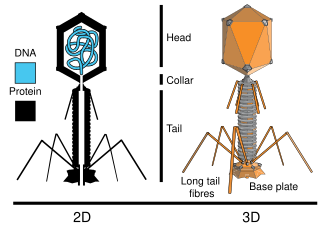Suppressor mutation
Suppressor Mutation[edit]

A suppressor mutation is a genetic mutation that counteracts the effects of another mutation. This type of mutation can restore the original phenotype by compensating for the defect caused by the initial mutation. Suppressor mutations can occur within the same gene as the original mutation (intragenic suppression) or in a different gene (extragenic suppression).
Types of Suppressor Mutations[edit]
Intragenic Suppression[edit]
Intragenic suppressor mutations occur within the same gene as the original mutation. These mutations can restore the function of the protein by altering the amino acid sequence in a way that compensates for the defect caused by the original mutation. For example, a second mutation might restore the reading frame in a gene affected by a frameshift mutation.
Extragenic Suppression[edit]
Extragenic suppressor mutations occur in a different gene than the one containing the original mutation. These mutations can restore the phenotype by affecting a different protein that interacts with the protein affected by the original mutation. For instance, a mutation in a tRNA gene that allows it to recognize a stop codon as a sense codon can suppress a nonsense mutation in another gene.
Mechanisms of Suppression[edit]
Suppressor mutations can operate through various mechanisms, including:
- Compensatory changes in protein structure: Alterations in the protein structure that restore function.
- Changes in gene expression: Modifications in the expression levels of genes that compensate for the defective protein.
- Alterations in metabolic pathways: Adjustments in metabolic pathways that bypass the block caused by the original mutation.
Importance in Genetic Research[edit]
Suppressor mutations are valuable tools in genetic research. They can help identify interactions between proteins and pathways, elucidate the function of genes, and provide insights into the mechanisms of genetic diseases. By studying suppressor mutations, researchers can better understand the complexity of genetic networks and the robustness of biological systems.
Related Pages[edit]
Ad. Transform your life with W8MD's Budget GLP-1 injections from $75


W8MD offers a medical weight loss program to lose weight in Philadelphia. Our physician-supervised medical weight loss provides:
- Weight loss injections in NYC (generic and brand names):
- Zepbound / Mounjaro, Wegovy / Ozempic, Saxenda
- Most insurances accepted or discounted self-pay rates. We will obtain insurance prior authorizations if needed.
- Generic GLP1 weight loss injections from $75 for the starting dose.
- Also offer prescription weight loss medications including Phentermine, Qsymia, Diethylpropion, Contrave etc.
NYC weight loss doctor appointmentsNYC weight loss doctor appointments
Start your NYC weight loss journey today at our NYC medical weight loss and Philadelphia medical weight loss clinics.
- Call 718-946-5500 to lose weight in NYC or for medical weight loss in Philadelphia 215-676-2334.
- Tags:NYC medical weight loss, Philadelphia lose weight Zepbound NYC, Budget GLP1 weight loss injections, Wegovy Philadelphia, Wegovy NYC, Philadelphia medical weight loss, Brookly weight loss and Wegovy NYC
|
WikiMD's Wellness Encyclopedia |
| Let Food Be Thy Medicine Medicine Thy Food - Hippocrates |
Medical Disclaimer: WikiMD is not a substitute for professional medical advice. The information on WikiMD is provided as an information resource only, may be incorrect, outdated or misleading, and is not to be used or relied on for any diagnostic or treatment purposes. Please consult your health care provider before making any healthcare decisions or for guidance about a specific medical condition. WikiMD expressly disclaims responsibility, and shall have no liability, for any damages, loss, injury, or liability whatsoever suffered as a result of your reliance on the information contained in this site. By visiting this site you agree to the foregoing terms and conditions, which may from time to time be changed or supplemented by WikiMD. If you do not agree to the foregoing terms and conditions, you should not enter or use this site. See full disclaimer.
Credits:Most images are courtesy of Wikimedia commons, and templates, categories Wikipedia, licensed under CC BY SA or similar.
Translate this page: - East Asian
中文,
日本,
한국어,
South Asian
हिन्दी,
தமிழ்,
తెలుగు,
Urdu,
ಕನ್ನಡ,
Southeast Asian
Indonesian,
Vietnamese,
Thai,
မြန်မာဘာသာ,
বাংলা
European
español,
Deutsch,
français,
Greek,
português do Brasil,
polski,
română,
русский,
Nederlands,
norsk,
svenska,
suomi,
Italian
Middle Eastern & African
عربى,
Turkish,
Persian,
Hebrew,
Afrikaans,
isiZulu,
Kiswahili,
Other
Bulgarian,
Hungarian,
Czech,
Swedish,
മലയാളം,
मराठी,
ਪੰਜਾਬੀ,
ગુજરાતી,
Portuguese,
Ukrainian